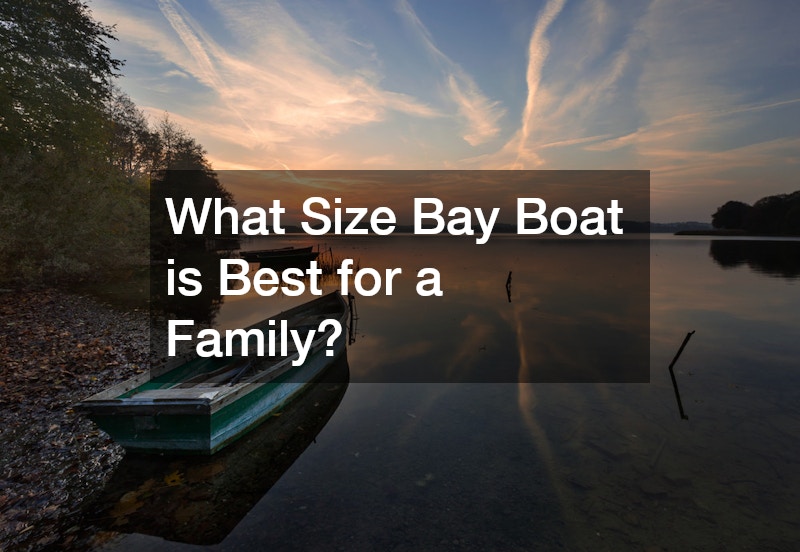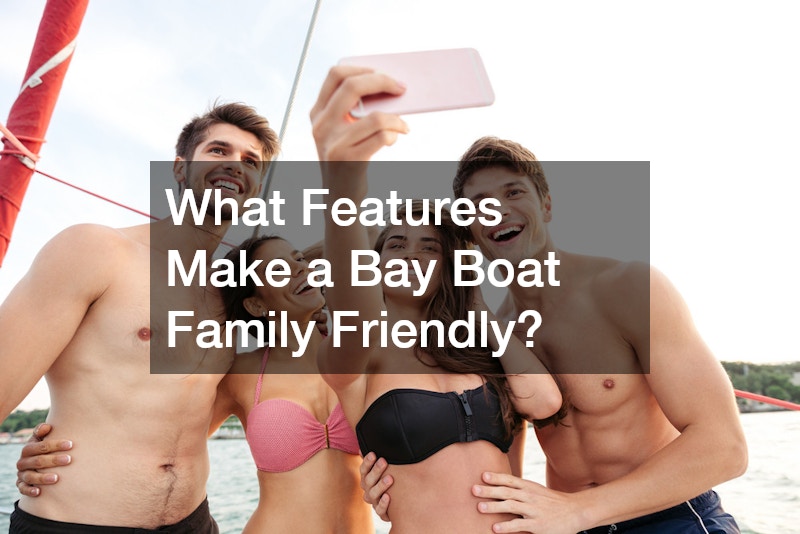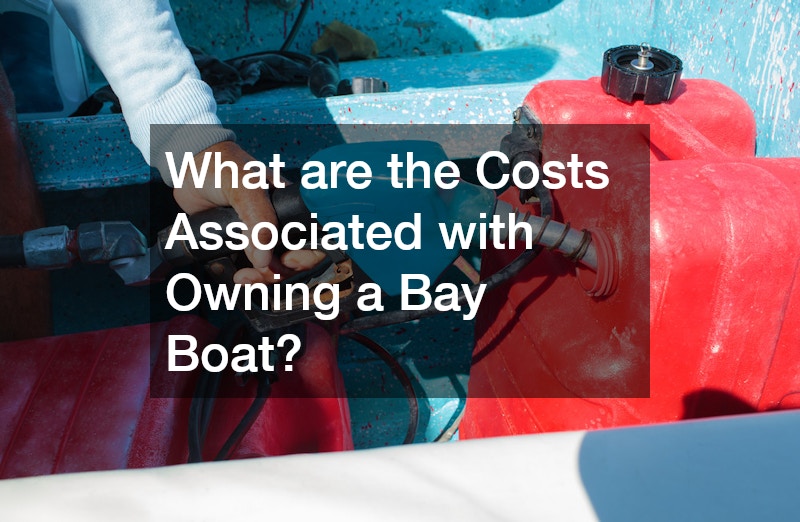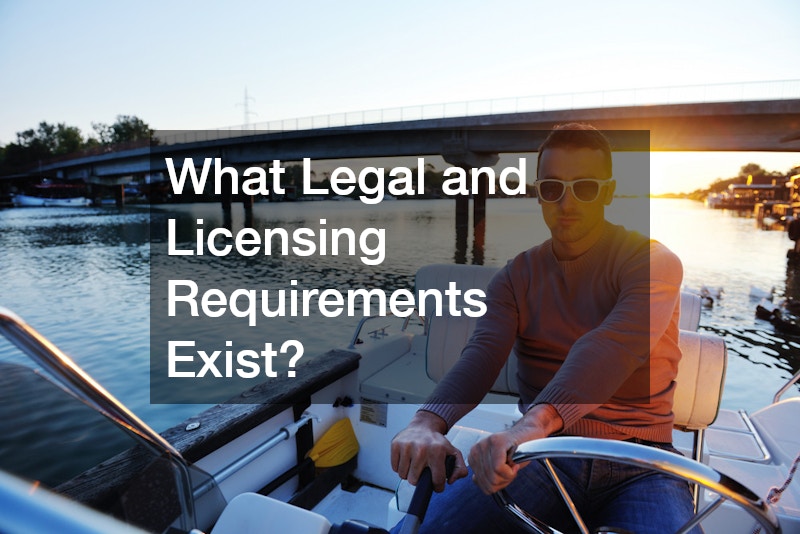Purchasing a family-friendly bay boat can open up a whole new world of fun and adventure on the water. From fishing trips to day cruises, a well-chosen boat can be the perfect way to spend time together outdoors. However, making the right choice can be challenging, especially with all the options and features available. This guide will cover ten essential aspects to consider when selecting a family-friendly bay boat, so you can make a confident and well-informed decision for your family’s needs.
1. What Size Bay Boat is Best for a Family?

A. Determining the Right Length
The size of your boat impacts both comfort and functionality. For families, a boat between 18 and 26 feet in length is often ideal, as it offers a good balance of space without becoming too challenging to maneuver. Boats on the smaller side are often easier to tow and store, while larger boats provide more comfort for longer excursions.
B. Beam Width Considerations
The beam, or width of the boat, affects stability and available space. A wider beam is typically more stable on the water, which is ideal when there are children onboard. This extra width also allows for wider walkways and roomier seating configurations, ensuring everyone can move around safely and comfortably.
C. Space for Seating and Movement
Families with multiple members need enough seating to accommodate everyone comfortably. Check that the boat layout provides adequate seating while allowing free movement around the deck. Additionally, a boat with well-planned seating arrangements, similar to those in a tritoon rental, provides greater flexibility for larger families.
D. Storage Capacity for Family Items
Families often bring along extra items, such as towels, coolers, toys, and life vests. Look for a boat with ample storage options, including compartments under the seats or in the floor. Proper storage helps prevent clutter and keeps the deck organized for safer movement.
E. Impact on Handling and Performance
Remember that as boat size increases, handling and performance may be affected. Larger boats typically require more powerful engines and may feel less nimble, especially for novice operators. If you’re new to boating or plan to navigate narrow waterways, consider a size that strikes a balance between space and ease of handling.
2. How Important is Safety in a Family-Friendly Bay Boat?
A. Essential Safety Features
A family-friendly bay boat must have essential safety features like sturdy handrails, nonslip boat deck flooring, and fire extinguishers. Such features are crucial to ensure peace of mind while on the water, especially with younger children onboard.
B. Childproofing Considerations
If you have small children, consider childproofing the boat. Look for nonslip surfaces, secure railings, and lower seating heights to prevent falls. Some boats also offer additional childproofing options for added security, which can make outings more enjoyable and stress-free.
C. Importance of Flotation Devices
Every passenger should have a suitable flotation device. Life vests and throwable flotation aids are essential safety items, and they should be stored in easily accessible areas. Many family-friendly boats come with designated storage areas for these items.
D. Navigational Safety Tools
Equipping your boat with a GPS tracking system enhances safety, especially in unfamiliar waters. GPS helps prevent getting lost and allows you to quickly locate help if needed. For families with adventurous spirits, this feature is especially valuable.
E. Emergency Protocols and First Aid
A well-prepared boat includes a first-aid kit and knowledge of basic emergency protocols. Familiarize yourself with potential emergency situations and ensure your family knows where the emergency equipment is located. A portable toilet can also be helpful on longer outings, ensuring comfort for everyone onboard.
3. What is the Best Seating Configuration for Families?
A. Comfort and Space
Comfortable seating is essential for family outings, especially if you plan on spending long hours on the water. Look for seats with thick cushioning and durable upholstery. Many family-friendly bay boats come with bench seating along the back, which can be ideal for families.
B. Convertible Seating Options
Some boats offer convertible seating that can be rearranged into loungers or sunbathing platforms. This flexibility allows everyone to enjoy the boat in different ways, whether it’s for sitting, lounging, or sunbathing.
C. Accessibility and Movement
A boat with wide walkways and minimal obstructions allows for safe movement around the deck. This is especially important when children are on board, as it reduces tripping hazards and ensures they can move about safely.
D. Shade and Protection
Consider a boat with a canopy or bimini top to provide shade, which is important for comfort and protection from the sun. A custom dock or shaded area offers relief from the elements and is beneficial for family members of all ages.
E. Durability and Maintenance
Family boats need to withstand heavy use, so durable seating materials are essential. Vinyl or marine-grade upholstery is often the best choice, as it resists water, sun damage, and frequent cleaning.
4. What Features Make a Bay Boat Family Friendly?

A. Entertainment Systems
An onboard entertainment system with Bluetooth speakers or satellite radio can keep everyone entertained. Music adds to the enjoyment of any outing and can help create a lively and memorable atmosphere.
B. Fishing Amenities
If your family enjoys fishing, look for fishing-specific features such as rod holders, tackle storage, and live wells for keeping bait and catches fresh. Fishing gear on board can be fun for the entire family, encouraging everyone to participate.
C. Swimming and Diving Access
Easy water access, such as a swim platform or ladder, is a must-have. This feature makes it easier for family members to enter and exit the water, whether for swimming, snorkeling, or diving.
D. Versatility for Different Activities
A versatile family boat is designed to accommodate various activities, from fishing to tubing and picnicking. Look for boats with features that support multiple uses, so you can adapt the boat to your family’s favorite pastimes.
E. Weather Adaptability
Weather can change quickly on the water, so it’s helpful to have features that make the boat adaptable, such as an all-weather cover or boat detailing that helps protect surfaces from sun and rain.
5. How do Engine Types Affect Family Usage?
A. Understanding Outboard Engines
Outboard engines are known for their maneuverability and easy maintenance. For families, this can be beneficial as it leaves more open deck space and makes it easier to service.
B. Inboard Engine Advantages
Inboard engines are quieter and provide a smoother ride, which can be ideal for families who prioritize comfort over speed. They’re often a better choice if you’re looking for quieter cruising experiences.
C. Impact of Horsepower
Horsepower needs vary based on your intended activities. Higher horsepower is essential if you plan on watersports like tubing or wakeboarding. However, for relaxed family outings, moderate horsepower may be more fuel-efficient and suitable.
D. Fuel Efficiency Issues
Opt for an engine with good fuel efficiency if you plan on frequent family outings. Fuel-efficient engines save money and are often more environmentally friendly, making them a practical choice for family use.
E. Noise Levels and Operation
Families with young children may prefer quieter engines to avoid startling or disturbing them. Inboard engines tend to be quieter, so consider this option if engine noise is a concern.
6. What are the Costs Associated with Owning a Bay Boat?

A. Initial Purchase Price
The price of a bay boat can vary widely based on size, brand, and features. Establish a budget and research boats within that range to avoid overspending on features you may not need.
B. Maintenance Costs
Boat maintenance can add up quickly. Routine maintenance includes everything from engine checks to boat repair, so it’s wise to factor these costs into your budget.
C. Insurance Fees
Insurance is essential for protecting your investment. Depending on your location, factors like the type of boat and coverage level may impact premiums. Compare different insurance plans to find the best coverage for your family’s needs.
D. Storage and Marina Fees
Unless you have a custom dock at home, you’ll likely need to store your boat at a marina, which involves additional fees. If your family is planning frequent trips, ensure that your marina location is convenient.
E. Depreciation Over Time
Like vehicles, boats depreciate over time. If you’re planning to upgrade in the future, consider how well the boat holds its value to minimize losses upon resale.
7. What Type of Fishing Gear is Suitable for a Family Bay Boat?
A. Rod Storage Solutions
On family trips, having secure rod storage is essential for safety and convenience. Many boats offer built-in rod holders that keep rods safely stored when not in use.
B. Built-In Tackle Storage
Tackle storage can help keep gear organized and accessible, which is particularly useful on family outings when everyone may be handling fishing gear.
C. Fish-Finding Technology
A GPS tracking system equipped with fish-finding technology can enhance fishing trips, making it easier to locate fishing spots and helping younger family members participate in the experience.
D. Live Wells and Bait Storage
Live wells and bait storage add convenience and allow the entire family to enjoy the fishing experience without worrying about keeping bait fresh.
E. Cleaning and Processing Space
Having a designated area for cleaning fish ensures the rest of the boat remains clean, making it easier to enjoy a day on the water without concerns about mess.
8. How Can a Bay Boat Enhance Family Bonding?
A. Opportunities for Teamwork
Boating as a family encourages teamwork, from packing for the trip to anchoring and navigating. These shared tasks foster a sense of cooperation and strengthen family bonds.
B. Learning New Skills Together
From operating a GPS to fishing, boating provides opportunities to learn new skills together, making every outing a learning experience for family members of all ages.
C. Planning Family Expeditions
Owning a boat allows you to plan family outings and explorations, fostering excitement and helping everyone look forward to shared adventures.
D. Capturing Memories on Water
Boating creates memorable photo opportunities and moments to capture on video. A bay boat provides an incredible backdrop for family memories that last a lifetime.
E. Encouraging Outdoor Activities
A family-friendly bay boat encourages outdoor recreation, teaching children to appreciate nature and offering everyone a break from technology.
9. What Legal and Licensing Requirements Exist?

A. Boating Licenses and Certifications
Many states require boating licenses or certifications, especially for those operating larger boats. Ensure all family members who will operate the boat are properly certified.
B. Safety Equipment Regulations
Each state has different requirements for safety equipment, such as flotation devices, fire extinguishers, and even portable toilets, so make sure you’re compliant.
C. State-Specific Laws
Be aware of any state-specific regulations that may affect your boating experience. Environmental protection laws, such as those affecting seawall upkeep, are also important to follow.
D. Environmental Compliance
Environmental regulations protect local ecosystems. Familiarize yourself with regulations on waste disposal, noise levels, and shoreline impact.
E. Import and Export Rules
If purchasing out-of-state or internationally, consider import and export regulations. Knowing the rules can prevent complications during purchase or resale.
10. How to Choose the Right Dealer or Broker?
A. Researching and Reviews
Research and read reviews before choosing a dealer or broker. A reputable dealer can provide valuable guidance and after-sales support.
B. Dealer Reputation and Credibility
Choose a dealer with a strong track record, who can offer assistance and advice, whether you’re looking at local boat sales or purchasing from a large distributor.
C. Customer Service and Support
Excellent customer service is essential, as you may need support with registration, repairs, or parts.
D. Negotiating Deals and Packages
Don’t hesitate to negotiate. Some dealers may offer packages that include trailers or extended maintenance plans, adding value to your purchase.
E. Post-Purchase Services and Maintenance
A dealer that provides post-purchase services can help keep your boat in top condition, ensuring you get the most out of your investment.
Buying a family-friendly bay boat is a rewarding investment that promises countless adventures. By considering factors such as size, safety, seating, and costs, you can select a boat that provides years of enjoyment and unforgettable memories. With the right boat, you’ll be well-equipped to explore the waters and create lasting family bonds.